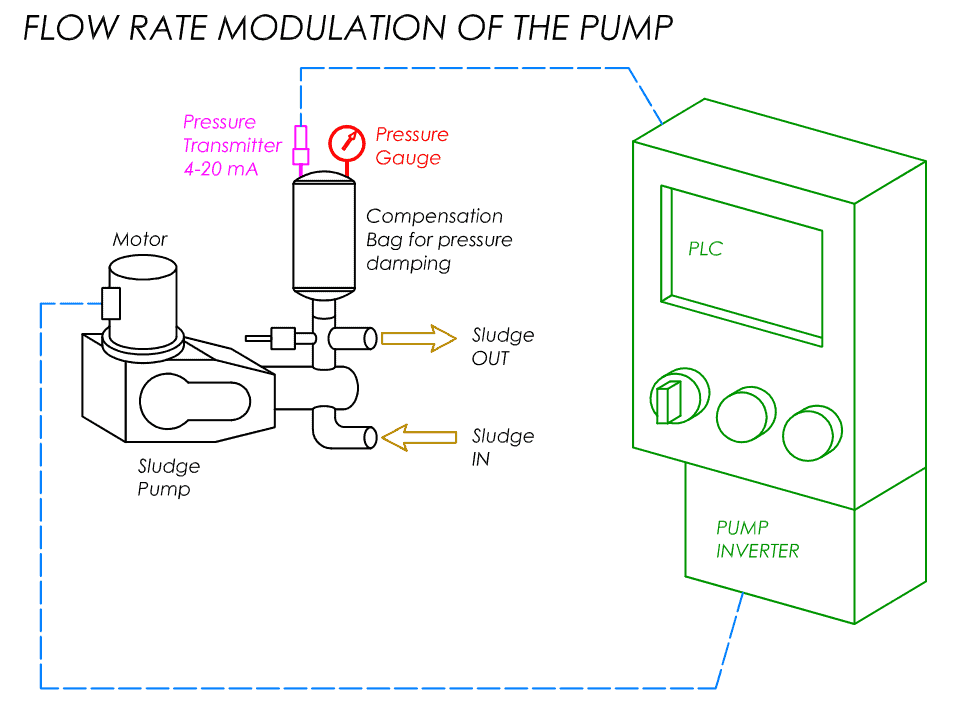Es práctica común pensar que la bondad del proceso de filtración depende únicamente del filtro prensa, y que la bomba no contribuye mucho a esta fase. Nada podría estar más equivocado: la bomba de alimentación juega un papel crucial en la filtración, a veces incluso en mayor medida que el filtro prensa. En primer lugar, la bomba debe ser capaz de obtener una torta sólida lo suficientemente compacta y deshidratada, y esto puede hacer que la presión de alimentación de los lodos deba alcanzar unos valores de presión determinados, por lo que hay casos en los que 6 bar pueden ser suficientes, pero los hay también casos en los que alcanza los 12-14 compases. Y la diferencia en términos de compacidad del panel, y por lo tanto en relación con el grado de sequedad, se paga al final del año cuando se calculan los costos de eliminación. Otro tema es el del caudal: no puedo enviar todo el caudal que quiero al filtro prensa, porque se taparían las telas, tendría una resistencia de entrada que se traduciría en una lectura incorrecta de la presión de alimentación de la bomba y Sería muy difícil gestionar el ciclo de filtración, ya que el caudal de la bomba debe ser adecuado a lo que el filtro prensa me permite recibir. Para comprender cómo elegir y administrar la bomba de alimentación, debe comenzar por cómo funciona el filtro prensa. Al comienzo del proceso de filtración, se requiere un alto caudal de la bomba de alimentación (consulte la sección sobre pruebas de laboratorio). Esta demanda continúa hasta que las cámaras entre las placas de filtración se llenan gradualmente con un producto sólido que se captura y concentra en lo que se denomina tortas. Debido a la creciente resistencia al flujo resultante a medida que el filtro se llena, la presión en la bomba aumenta, mientras que al mismo tiempo se debe reducir el flujo. Esto se debe a que la capacidad de succión del filtro prensa disminuye gradualmente. Esta es la mejor solución para estos casos en los que se quiere modular mejor la curva de filtración regulando la bomba de la mejor manera.
It is common to think that the quality of the filtration process depends only on the filter press, and that the pump does not contribute much to this phase.
Nothing could be more wrong: the feed pump plays a crucial role in filtration, sometimes even more than the filter press.
First of all, the pump must have the ability to obtain a sufficiently compact and dewatered solid cake, and this may mean that the feed pressure of the sludge must reach certain pressure values, so there are cases in which 6 bar may be enough, but there are also cases in which it reaches 12-14 bars.
And the difference in terms of the compactness of the panel – and therefore in relation to the degree of dryness – is paid at the end of the year when the disposal costs are taken into account.
Another issue is the one regarding the flow rate: I cannot send all the flow rate I want to the filter press, because the cloths would clog, I would have an input resistance which would result in an incorrect reading of the pump supply pressure and it would be very difficult to manage the filtration, as the pump flow rate must be adequate for what the filter press allows me to receive.
To understand how to choose and manage the feed pump, you need to start from how the filter press works.
At the beginning of the filtration process, a high flow rate is required from the feed pump (see the section on laboratory tests).
This request continues until the chambers between the filter plates gradually fill with the solid product which is captured and concentrated in what are called “cake”.
Due to the resulting increasing resistance to flow as the filter fills, the pressure in the pump increases, while at the same time the flow rate must be reduced.
This is due to the fact that the suction capacity of the filter press gradually decreases.
This is the best solution for these cases where you want to better modulate the filtration curve by adjusting the pump in the best way.

En las bombas de pistón de la serie “Libra” de Autemi es posible realizar esta importante función por medio de un sensor de presión analógico y un convertidor de frecuencia. De esta forma, el caudal inicial, el punto de ruptura y el caudal mínimo se ajustan fácilmente y, lo que es más importante, incluso se modifican si es necesario. La señal analógica del sensor de presión se envía directamente al convertidor de frecuencia (inversor). Este tipo de esquema de control para alimentar el filtro prensa ahorra energía.
Al mismo tiempo, permite el ajuste individual para obtener resultados de filtración óptimos: es el proceso de filtración el que controla la bomba de alimentación. De hecho, es importante evitar ciclos de filtración discontinuos o pulsantes, porque no ayuda a obtener compacidad en la torta de desecho.
In Autemi’s “Libra” series piston pumps it is possible to realize this important function by means of an analog pressure sensor and a frequency converter.
In this way the initial flow rate, breakpoint and minimum flow rate are easily set and, more importantly, also varied if necessary.
The analog signal from the pressure sensor is sent directly to the frequency converter (inverter).
This type of control scheme for powering the filter press saves energy.
At the same time, it allows for individual adjustment for optimal filtration results – it is the filtration process that controls the feed pump.
It is in fact important to avoid discontinuous or pulsating filtration cycles, because it does not help to obtain compactness in the discharge panel.